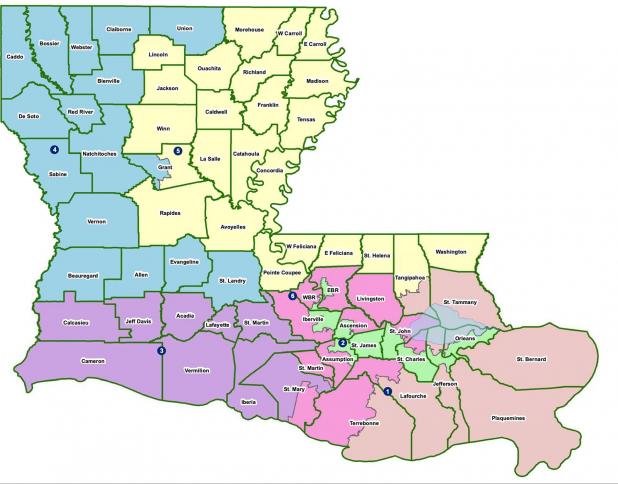
Special House map session over minority district is on again; St. Mary has another stake in marp
The exact shape of St. Mary Parish’s representation in Congress is up in the air again.
Louisiana legislators were to go back into session Wednesday to redraw the map of U.S. House districts after a 5th U.S. District Court of Appeals ruling
Sunday.
That ruling lifted a stay delaying implementation of a lower court ruling throwing out the district map approved by lawmakers this session with a rare override of a veto by Gov. John Bel Edwards.
The controversy is over whether one or two of Louisiana’s six congressional districts should have a Black majority. The map approved by the Legislature maintained one Black-majority district.
That map also splits St. Mary between two House districts, with the majority of the parish remaining in the 3rd District while portions of the extreme eastern part of the parish go to the 6th District.
U.S. District Judge Shelly Dick struck down that map earlier this month and ordered the Legislature to go back into session to redraw a map with two winnable districts for a Black candidate.
The 5th Circuit blocked implementation of the ruling Thursday on what Edwards called procedural grounds. Then the 5th Circuit vacated its earlier move, giving the apparent go-ahead for the special session called by Edwards.
Republican legislative leaders challenged Dick’s ruling and had expressed confidence to reporters that conservative 5th Circuit would block the lower court order.
“This is a big step in the right direction for the people of Louisiana, and I’m thankful to the U.S Fifth Circuit for lifting the stay,” Edward said in a press release. “This has always been a straightforward case of simple math, simple fairness and the rule of law.
“According to the U.S. Census, African Americans make up nearly one-third of the voting population in Louisiana, and therefore, we should have a second majority minority congressional district.”
“The 5th Circuit has not yet considered the merits of the case,” said state Sen. Sharon Hewitt, R-Slidell and the map’s key backer in the Senate, quoted by the Center Square. “The legislative branch, executive branch, and judicial branch all have a role, with great deference given to the legislative branch, which has the constitutional responsibility to redistrict. We will continue to carry out our responsibilities.”
The Legislature must redraw most political district maps after each U.S. census to maintain the one person, one vote principle. Remapping is always rife with hardball politics, and that’s especially true this year.
The Legislature’s override of Edwards’ February veto of the map with one Black-majority district is considered by some to be a shift in power between the state’s executive and legislative branches.
Republicans have hopes of recapturing control of the U.S. House in this year's mid-terms. Adding a winnable district for an African American candidate could mean losing a Louisiana seat now represented by a Republican while the Democrats pick up a seat.
This is also the first time in more than half a century when the Legislature was not required to submit the House map to the U.S. Justice Department for “pre-clearance” under Section 5 of the 1965 Voting Rights Act. The U.S. Supreme Court struck down the pre-clearance requirement in its 2013 Shelby County v. Holder decision.
But Shelby left intact the act’s Section 2, which allows for after-the-fact challenges to voting law changes that weaken minority voting strength. Dick’s ruling referred to Section 2 and said the court will redraw Louisiana’s House district map if the Legislature can’t settle on one with two Black-majority districts.
After the 1990 Census, the first Bush administration’s Justice Department took a hard line on not just protecting minority voting rights, but on expanding those rights. That resulted in a second Black-majority congressional district in Louisiana, which still had seven House seats at the time.
The first Black-majority district, the rough boundaries of which exist today, was centered on New Orleans. In order to pick up enough black residents, the
second stretched from Shreveport to Monroe, southwest past Alexandria to Lafayette and then east to Baton Rouge and the north shore.
But the Supreme Court struck down that district on the grounds that it relied on racial categories to an impermissible degree.
The 2020 Census found that 32.8% of Louisiana’s population is African-American.
